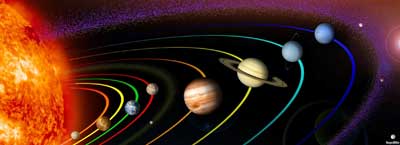
Some 450 light-years from Earth, embryonic planets may be feeding tendrils of gas to the newborn star they orbit. The discovery helps explain how a young star can grow even as budding planets suck up much of the gas and dust around it. Without the tendrils replenishing it, the star’s supply of gas would disappear in less than a year.
Jupiter and Saturn may have done something similar for the sun in its early  days, 4.5 billion years ago. “This is one of the nearest examples of the birth of a solar system,” says Simon Casassus, an astronomer at the University of Chile. He and his colleagues describe the finding online January 2 in Nature.
days, 4.5 billion years ago. “This is one of the nearest examples of the birth of a solar system,” says Simon Casassus, an astronomer at the University of Chile. He and his colleagues describe the finding online January 2 in Nature.
The star in question is named HD 142527, in the southern constellation Lupus. It’s about twice the mass of the sun but far younger, only about 2 million years old. Astronomers knew it was surrounded by a swirling disk of gas and dust, which has a big clearing in it from about 10 times to 140 times the Earth-sun distance. They think a big budding planet — something like Jupiter in its very early days — might orbit its star at about 90 times the Earth-sun distance, clearing out a gap like a snowplow shoveling roads.
Casassus’ team looked at this gap using the ALMA array of radio telescopes in Chile, which can detect faint emissions from gases such as carbon monoxide. The team found some of this gas drifting through the gap — probably leftover stuff that the protoplanet hadn’t cleared away, Casassus says.
More intriguingly, denser gas formed several filaments stretching across the gap. These streamers are almost certainly guided and shaped by protoplanets embedded within them, Casassus says.
The filaments are faint, says University of Hawaii astronomer Jonathan Williams, but “my gut reaction is that their interpretation is probably correct and that this is an exciting result.”
Simulations of how the gas might flow suggest not one but at least two big protoplanets surround the star. One, of around 10 Jupiter masses, probably orbits at the expected 90 times the Earth-sun distance. A second, of around 4 Jupiter masses, may orbit closer in, at around 40 times the Earth-sun distance. “At this point, we can’t tell how many objects orbit the star,” cautions Sally Dodson-Robinson, an astronomer at the University of Texas at Austin.
Astronomers haven’t yet directly spotted any protoplanets around HD 142527, but they keep looking. The Nature paper relies on one hour’s worth of observations from ALMA; Casassus has six more hours of data that should be arriving on his desk within the next few weeks. “There’s lots more to come,” he says.
Science News Magazine
M.W

